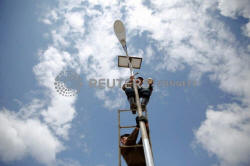Cheap solar panels power consumer appliance boom in
North Korea
 Send a link to a friend
Send a link to a friend
 [April 18, 2019]
By Hyonhee Shin [April 18, 2019]
By Hyonhee Shin
SEOUL (Reuters) - Years after they first
appeared in North Korea, increasingly cheap and available solar panels
are giving a boost to consumer consumption and industry as Pyongyang
tries to limit the impact of tough international sanctions.
Electricity shortages have been a perennial concern for North Korea, and
leader Kim Jong Un has called for greater use of renewable energy as
part of his drive for self-sufficiency as sanctions have ratcheted
higher in response to the country's nuclear and missile programs.
Now ever more households, factories and businesses are equipped with
solar panels, leading to a greater variety of home electronics products
available in increasingly common private markets known as jangmadang,
defectors and recent visitors say.
Among the hottest selling items are water purifiers, hair straighteners
and electric bicycles, mostly from China but some made in North Korea or
even smuggled in from South Korea.

"A few years ago, such things as water purifiers, mixers and rice
cookers were only seen at some restaurants and rich households, but they
are becoming commonplace, especially in cities," said Kang Mi-jin, an
economic expert who regularly speaks with North Koreans for Daily NK, a
website run by defectors.
"Some would look just like an ordinary middle-class South Korean home,
with a wall-hanging LED TV, multiple laptops and electric mini cars for
babies."
CONSUMER CULTURE
North Koreans started using solar panels several years ago, mostly to
charge mobile phones and light their homes as a backup to the unstable,
mostly hydro and coal-fired national grid.
As well as markets brimming with electronics products, there are more
teahouses, computer games rooms, karaoke bars and billiard halls open
longer after switching to solar from diesel generators, according to
recent visitors and defectors.
Such entertainment venues are becoming more widespread, not only in
cities, but also the countryside, where grid power is even less
reliable.
"At night, often it is only those places that have solar panels and
batteries that have lights on," a source with knowledge of the issue
told Reuters on condition of anonymity due to the sensitivity of North
Korea affairs.

Use of the panels spread after they were used at a now-closed
inter-Korean factory park in the North's border city of Kaesong that
opened in 2004.
"Now many apartment balconies have them out in the sun during the day
collecting energy so they are readily visible, the source said.
Private use of solar panels has gone from being officially banned, to
tolerated, to encouraged by the ruling Workers' Party, which keeps a
tight rein on the economy and the populace.
Early this month, the official Rodong Sinmun ran an article about a team
of laborers at a cooperative farm who earned solar panels and LED TVs as
a reward from the Party for surpassing a production goal.
State television has also aired a series of reports on the growing use
of solar energy over the past year, including a 17-minute documentary
from October introducing locally made devices, such as high-voltage
inverters and even a portable charger for electric bicycles.
[to top of second column] |

A man paints a solar
street lamp in the suburbs of Pyongyang, North Korea May 4, 2016.
REUTERS/Damir Sagolj/File Photo

Kim Yun-soung, a research fellow at the Green Energy Strategy Institute in
Seoul, said the North's push for domestic production of solar equipment was
spurred by sanctions banning imports of metal products.
"Electricity was the biggest problem but we achieved such a highly advanced,
cutting-edge technology ourselves from scratch, which was once monopolized by
developed nations," the film's narrator said, referring to the inverters.
State media has listed the central bank, schools, factories, and even ferries as
entirely powered by solar panels.
"A solar panel gives you 'free' power once it is installed," said Kim Young Hui,
a defector and an economist at the South's state-run Korea Development Bank.
"So the nature of the panels perfectly fits Kim Jong Un's mantra of
self-reliance - or in other words, creating something out of nothing."
'FREE POWER'
Most of the panels sold in markets were brought in from China, and prices have
dropped by up to 40 percent over the last few years amid a global glut and
rising North Korean production, defectors and experts said.
In 2015, sources told Reuters a small 20-watt panel was sold at about $44. These
days a 30-watt panel - a more widely used model - costs only about $15, Kang
said.

Pyongyang does not provide data on its use of solar power, but Kang said about
55 percent of North Korean households are equipped with the panels. The ratio is
higher in Pyongyang and other cities, as well as border regions where Chinese
goods are widely available, she said.
David von Hippel, an Oregon-based senior associate at the Nautilus Institute, a
U.S. think tank, said North Korea has imported a total of 29 megawatts of solar
panels from China through 2017, citing Beijing's custom data.
Experts say solar energy still account for less than 0.1 percent of the
country's generation capacity, estimated by South Korea's statistics agency at
some 7,700 megawatts as of 2017.
Pyongyang aims to boost its renewable capacity to 5,000 megawatts by 2044, with
a focus on wind power, according to state media.
Panels play a key role in soothing public discontent toward the Kim regime over
chronic power shortages and sanctions, defectors and observers say.
"Kim Jong Un appears to be committed to economic reform," von Hippel said. "So
the increased access to energy in some ways relieves the government from having
to supply its citizens with energy."
(Reporting by Hyonhee Shin. Editing by Lincoln Feast.)
[© 2019 Thomson Reuters. All rights
reserved.] Copyright 2019 Reuters. All rights reserved. This material may not be published,
broadcast, rewritten or redistributed.
Thompson Reuters is solely responsible for this content.
 |